Extreme Ultraviolet Lighting Using Carbon Nanotube-Based Cold Cathode Electron Beam
Abstract
1. Introduction
2. Materials and Methods
3. Results
3.1. Carbon Nanotube-Based Cold Cathode Electron Beam for Extreme Ultraviolet Lighting
3.1.1. Schematic
3.1.2. Current-Voltage Characteristics
3.2. EUV Confirmation by Photodiode and Filter
3.2.1. Photocurrent Response to Anode Voltage Change
3.2.2. Photocurrent Response to Anode Current Change
3.2.3. Photocurrent Response According to the Electron Incident Angle
3.3. Extreme Ultraviolet Light Generated by Direct Irradiation of Electrons for Photolithography
4. Discussion
5. Conclusions
Author Contributions
Funding
Institutional Review Board Statement
Informed Consent Statement
Data Availability Statement
Conflicts of Interest
References
- Fu, N.; Liu, Y.; Ma, X.; Chen, Z. EUV lithography: State-of-the-art review. J. Microelectron. Manuf. 2019, 2, 1–6. [Google Scholar] [CrossRef]
- Versolato, O.O. Physics of laser-driven tin plasma sources of EUV radiation for nanolithography. Plasma Sources Sci. Technol. 2019, 28, 083001. [Google Scholar] [CrossRef]
- Banine, V.Y.; Koshelev, K.; Swinkels, G. Physical processes in EUV sources for microlithography. J. Phys. D Appl. Phys. 2011, 44, 253001. [Google Scholar] [CrossRef]
- Beckers, J.; van de Ven, T.; van der Horst, R.; Astakhov, D.; Banine, V.J.A.S. EUV-induced plasma: A peculiar phenomenon of a modern lithographic technology. Appl. Sci. 2019, 9, 2827. [Google Scholar] [CrossRef]
- Egorov, N.; Sheshin, E. Field Emission Electronics; Springer: Berlin, Germany, 2017. [Google Scholar]
- Laszczyk, K.U. Field Emission Cathodes to Form an Electron Beam Prepared from Carbon Nanotube Suspensions. Micromachines 2020, 11, 260. [Google Scholar] [CrossRef] [PubMed]
- Giubileo, F.; Di Bartolomeo, A.; Iemmo, L.; Luongo, G.; Urban, F. Field emission from carbon nanostructures. Appl. Sci. 2018, 8, 526. [Google Scholar] [CrossRef]
- Lee, H.R.; Hwang, O.J.; Cho, B.; Park, K.C. Scanning electron imaging with vertically aligned carbon nanotube (CNT) based cold cathode electron beam (C-beam). Vacuum 2020, 182, 109696. [Google Scholar] [CrossRef]
- Milne, W.; Teo, K.; Minoux, E.; Groening, O.; Gangloff, L.; Hudanski, L.; Schnell, J.-P.; Dieumegard, D.; Peauger, F.; Bu, I. Aligned carbon nanotubes/fibers for applications in vacuum microwave amplifiers. J. Vac. Sci. Technol. B 2006, 24, 345–348. [Google Scholar] [CrossRef]
- Qian, X.; Tucker, A.; Gidcumb, E.; Shan, J.; Yang, G.; Calderon-Colon, X.; Sultana, S.; Lu, J.; Zhou, O.; Spronk, D. High resolution stationary digital breast tomosynthesis using distributed carbon nanotube x-ray source array. J. Med. Phys. 2012, 39, 2090–2099. [Google Scholar] [CrossRef]
- Choi, W.; Chung, D.; Kang, J.; Kim, H.; Jin, Y.; Han, I.; Lee, Y.; Jung, J.; Lee, N.; Park, G. Fully sealed, high-brightness carbon-nanotube field-emission display. Appl. Phys. Lett. 1999, 75, 3129–3131. [Google Scholar] [CrossRef]
- Yoo, S.T.; Park, K.C. Sapphire Wafer for 226 nm Far UVC Generation with Carbon Nanotube-Based Cold Cathode Electron Beam (C-Beam) Irradiation. ACS Omega 2020, 5, 15601–15605. [Google Scholar] [CrossRef] [PubMed]
- Oto, T.; Banal, R.G.; Kataoka, K.; Funato, M.; Kawakami, Y. 100 mW deep-ultraviolet emission from aluminium-nitride-based quantum wells pumped by an electron beam. Nat. Photonics 2010, 4, 767–770. [Google Scholar] [CrossRef]
- Gong, J.; Sumathy, K.; Qiao, Q.; Zhou, Z. Review on dye-sensitized solar cells (DSSCs): Advanced techniques and research trends. Renew. Sustain. Energy Rev. 2017, 68, 234–246. [Google Scholar] [CrossRef]
- Shoukat, R.; Khan, M.I. Carbon nanotubes: A review on properties, synthesis methods and applications in micro and nanotechnology. Microsyst. Technol. 2021, 27, 4183–4192. [Google Scholar] [CrossRef]
- Kamedulski, P.; Lukaszewicz, J.P.; Witczak, L.; Szroeder, P.; Ziolkowski, P. The importance of structural factors for the electrochemical performance of graphene/carbon nanotube/melamine powders towards the catalytic activity of oxygen reduction reaction. Materials 2021, 14, 2448. [Google Scholar] [CrossRef] [PubMed]
- Kim, D.; Lim, S.H.; Guilley, A.J.; Cojocaru, C.S.; Bourée, J.E.; Vila, L.; Ryu, J.; Park, K.; Jang, J. Growth of vertically aligned arrays of carbon nanotubes for high field emission. Thin Solid Films 2008, 516, 706–709. [Google Scholar] [CrossRef][Green Version]
- Lim, S.H.; Park, K.C.; Moon, J.H.; Yoon, H.S.; Pribat, D.; Bonnassieux, Y.; Jang, J. Controlled density of vertically aligned carbon nanotubes in a triode plasma chemical vapor deposition system. Thin Solid Films 2006, 515, 1380–1384. [Google Scholar] [CrossRef]
- Lee, S.W.; Kang, J.S.; Lee, H.R.; Park, S.Y.; Jang, J.; Park, K.C. Enhanced and stable electron emission of carbon nanotube emitters with graphitization. Vacuum 2015, 121, 212–216. [Google Scholar] [CrossRef]
- Powell, F.R.; Johnson, T.A. Filter windows for EUV lithography. In Proceedings of the Emerging Lithographic Technologies V, Santa Clara, CA, USA, 20 August 2001; pp. 585–589. [Google Scholar] [CrossRef]
- Chkhalo, N.; Gusev, S.; Drozdov, M.; Kluenkov, E.; Lopatin, A.Y.; Luchin, V.; Pestov, A.; Salashchenko, N.; Shmaenok, L.; Tsybin, N. Influence of annealing on the structural and optical properties of thin multilayer EUV filters containing Zr, Mo, and silicides of these metals. In Proceedings of the International Conference on Micro-and Nano-Electronics 2009, Berlin, Germany, 5–9 October 2009; p. 752105. [Google Scholar] [CrossRef]
- Kang, J.S.; Hong, J.H.; Park, K.C. High-performance carbon-nanotube-based cold cathode electron beam with low-thermal-expansion gate electrode. J. Vac. Sci. Technol. B 2018, 36, 02C104. [Google Scholar] [CrossRef]
- NIST Atomic Spectra Database (Ver. 5.8); National Institute of Standards and Technology: Gaithersburg, MD, USA. Available online: https://physics.nist.gov/asd (accessed on 3 April 2022).
- Wang, J.; Wang, X.; Zuo, D. Characteristics of laser induced discharge tin plasma and its extreme ultraviolet radiation. Front. Optoelectron. 2021, 14, 1–8. [Google Scholar] [CrossRef]
- An, W.; Krasik, Y.E.; Fetzer, R.; Bazylev, B.; Mueller, G.; Weisenburger, A.; Bernshtam, V. Characterization of high-current electron beam interaction with metal targets. J. Appl. Phys. 2011, 110, 093304. [Google Scholar] [CrossRef]
- Borisov, V.M.; Eltsov, A.V.; Ivanov, A.S.; Kiryukhin, Y.B.; Khristoforov, O.B.; Mishchenko, V.A.; Prokofiev, A.V.; Vinokhodov, A.Y.; Vodchits, V. EUV sources using Xe and Sn discharge plasmas. J. Phys. D Appl. Phys. 2004, 37, 3254–3265. [Google Scholar] [CrossRef]
- Tan, N.; Wu, P.; Hua, Y.; Sun, J.; Huang, W.; Huang, W. Experimental study of destructive effects on materials with different energy electron bombardment. AIP Adv. 2021, 11, 015349. [Google Scholar] [CrossRef]
- Rathore, A.; Pollentier, I.; Singh, H.; Fallica, R.; De Simone, D.; De Gendt, S. Effect of molecular weight on the EUV-printability of main chain scission type polymers. J. Mater. Chem. C 2020, 8, 5958–5966. [Google Scholar] [CrossRef]
- Manouras, T.; Argitis, P. High sensitivity resists for EUV lithography: A review of material design strategies and performance results. Nanomaterials 2020, 10, 1593. [Google Scholar] [CrossRef]
- Olivier, J.; Poirier, R. Electronic structure of Al2O3 from electron energy loss spectroscopy. Surf. Sci. 1981, 105, 347–356. [Google Scholar] [CrossRef]
- Yoo, S.T.; Kang, J.S.; Park, K.C. Enhanced Efficiency of Field Emission Lamps with Carbon Nanotube Cold Cathode and Beam Uniformity Enhancement Electrode (BEE). J. Nanosci. Nanotechnol. 2017, 17, 7362–7367. [Google Scholar] [CrossRef]
- Egbert, A.; Mader, B.; Tkachenko, B.; Ostendorf, A.; Fallnich, C.; Chichkov, B.N.; Miflalla, T.; Schuermann, M.C.; Gaebel, K.; Schriever, G. Compact electron-based extreme ultraviolet source at 13.5 nm. J. Micro/Nanolithogr. MEMS MOEMS 2003, 2, 136–139. [Google Scholar] [CrossRef]
- Egbert, A.; Tkachenko, B.; Becker, S.; Chichkov, B.N. Compact electron-based EUV source for at-wavelength metrology. In Proceedings of the High-Power Laser Ablation V, Taos, NM, USA, 20 September 2004; pp. 693–703. [Google Scholar] [CrossRef]
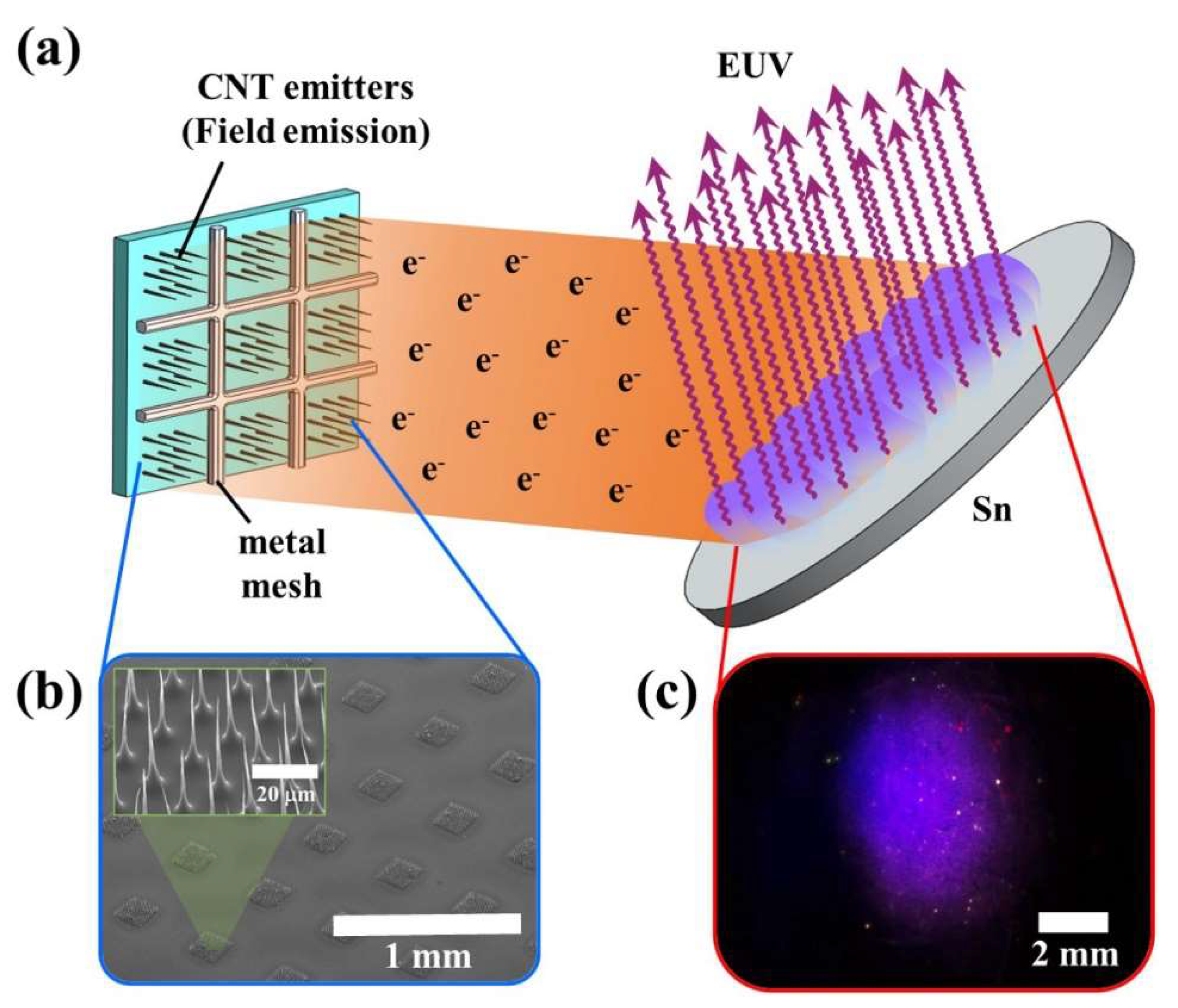

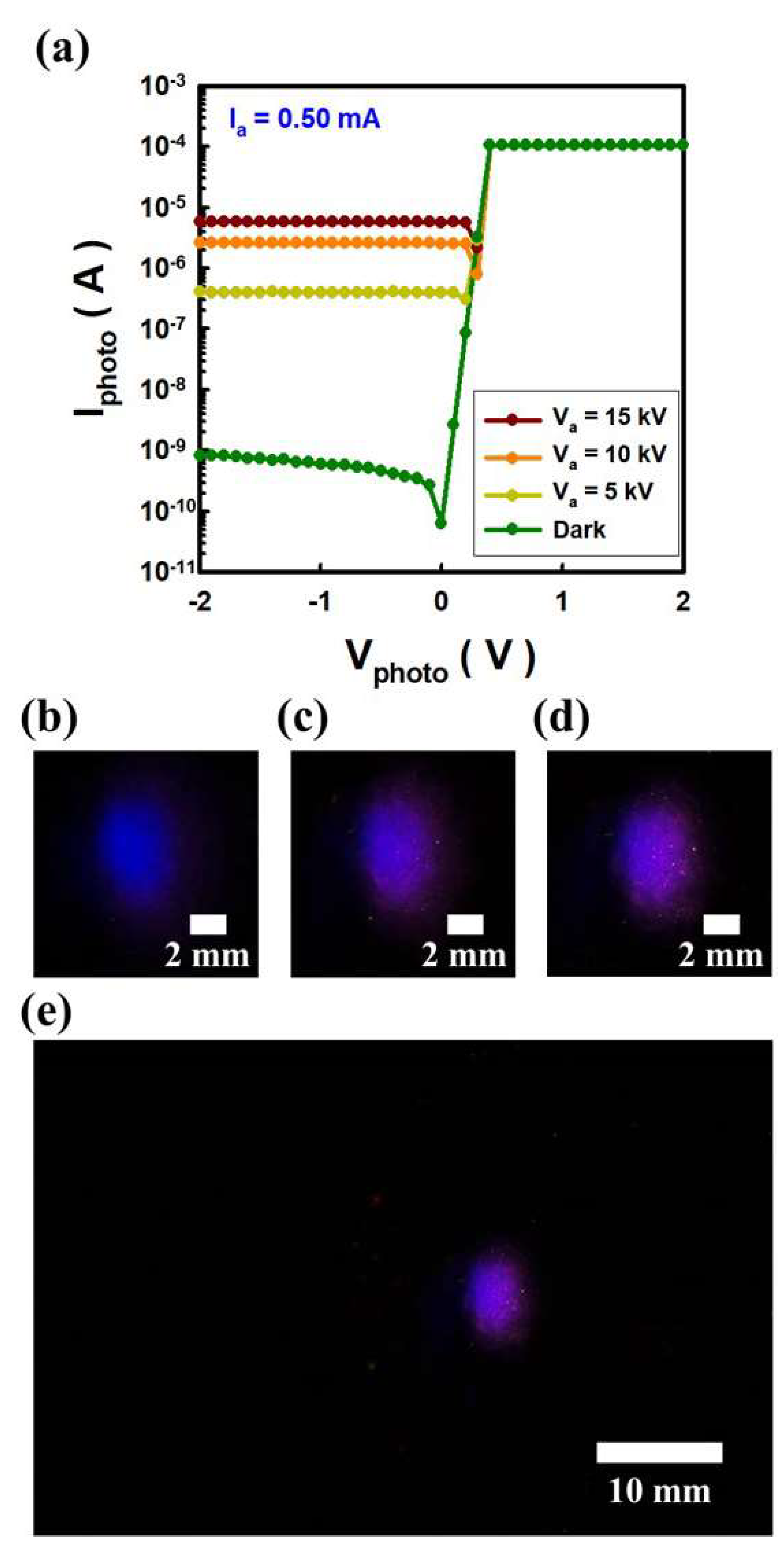


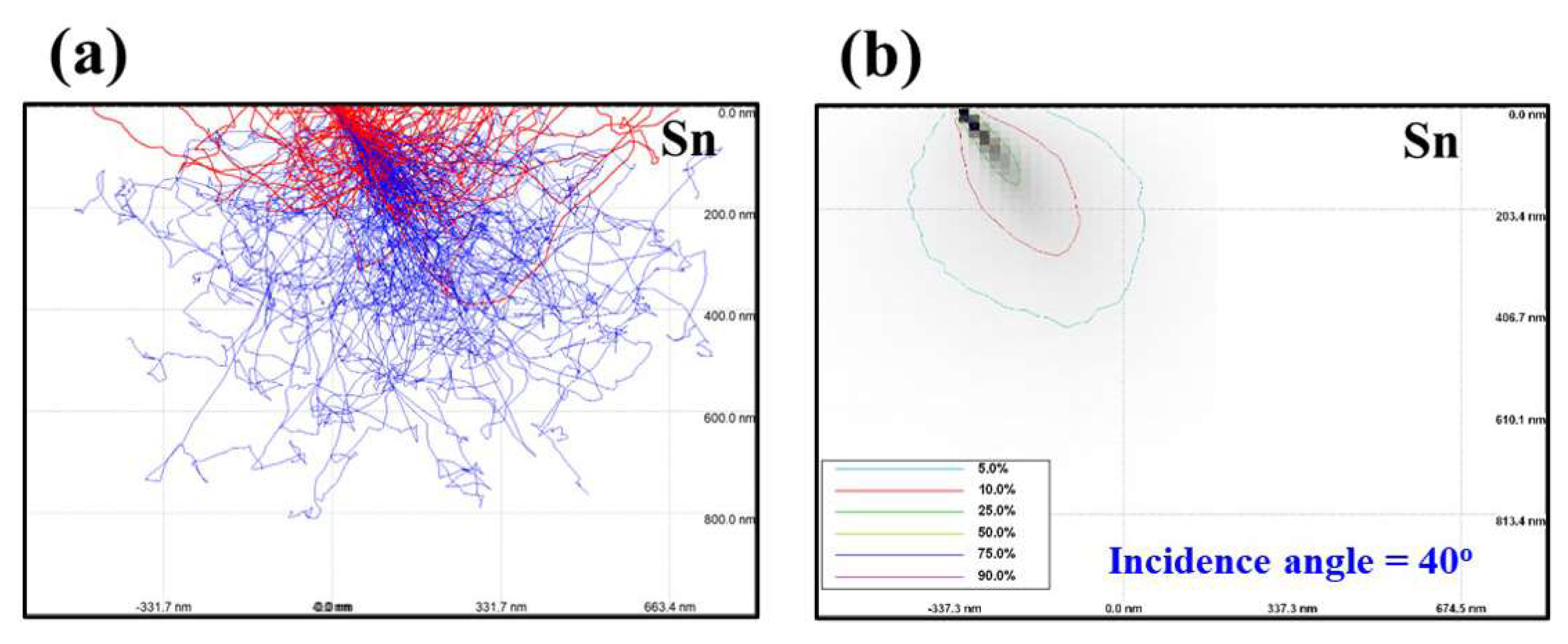
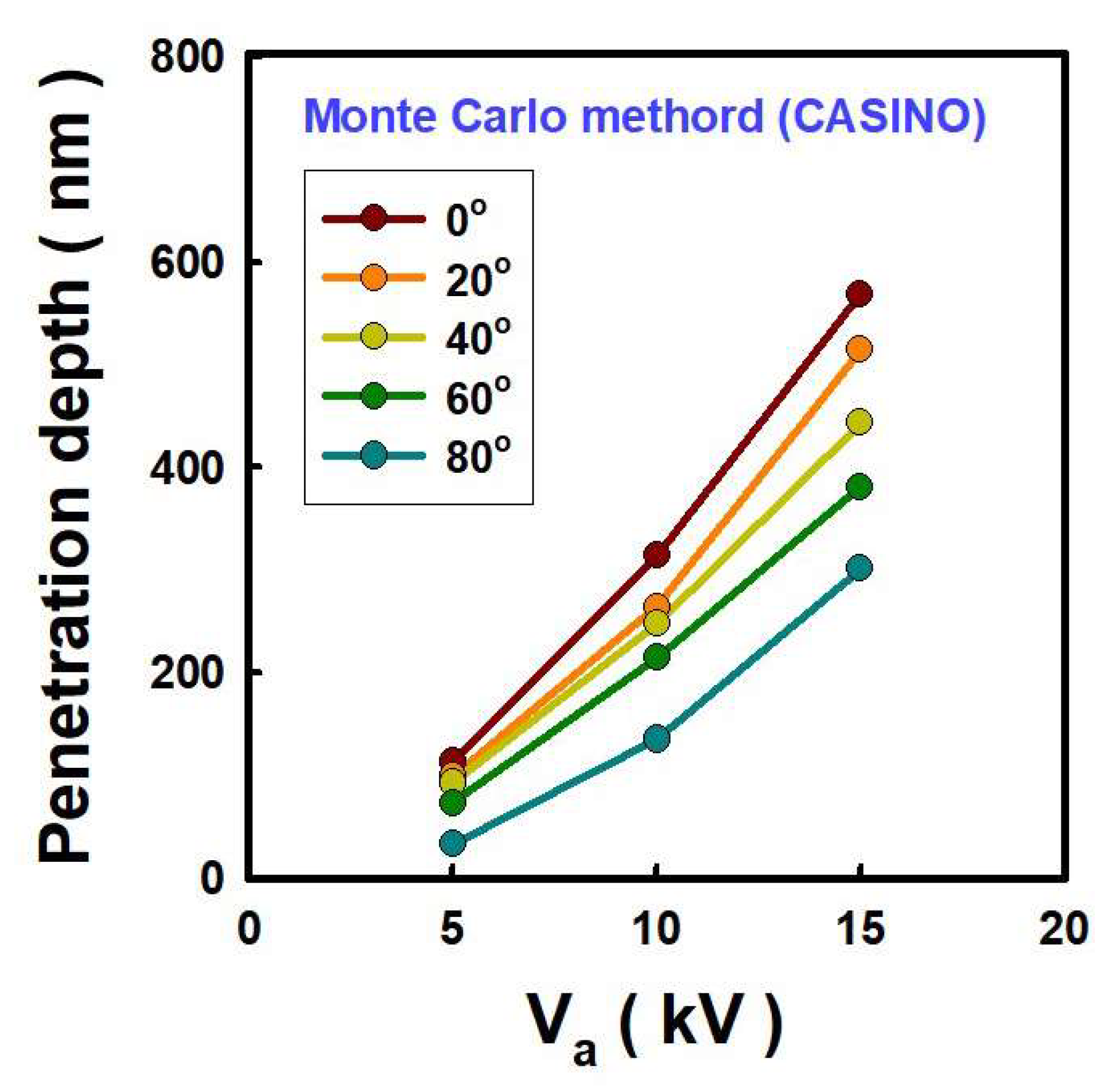

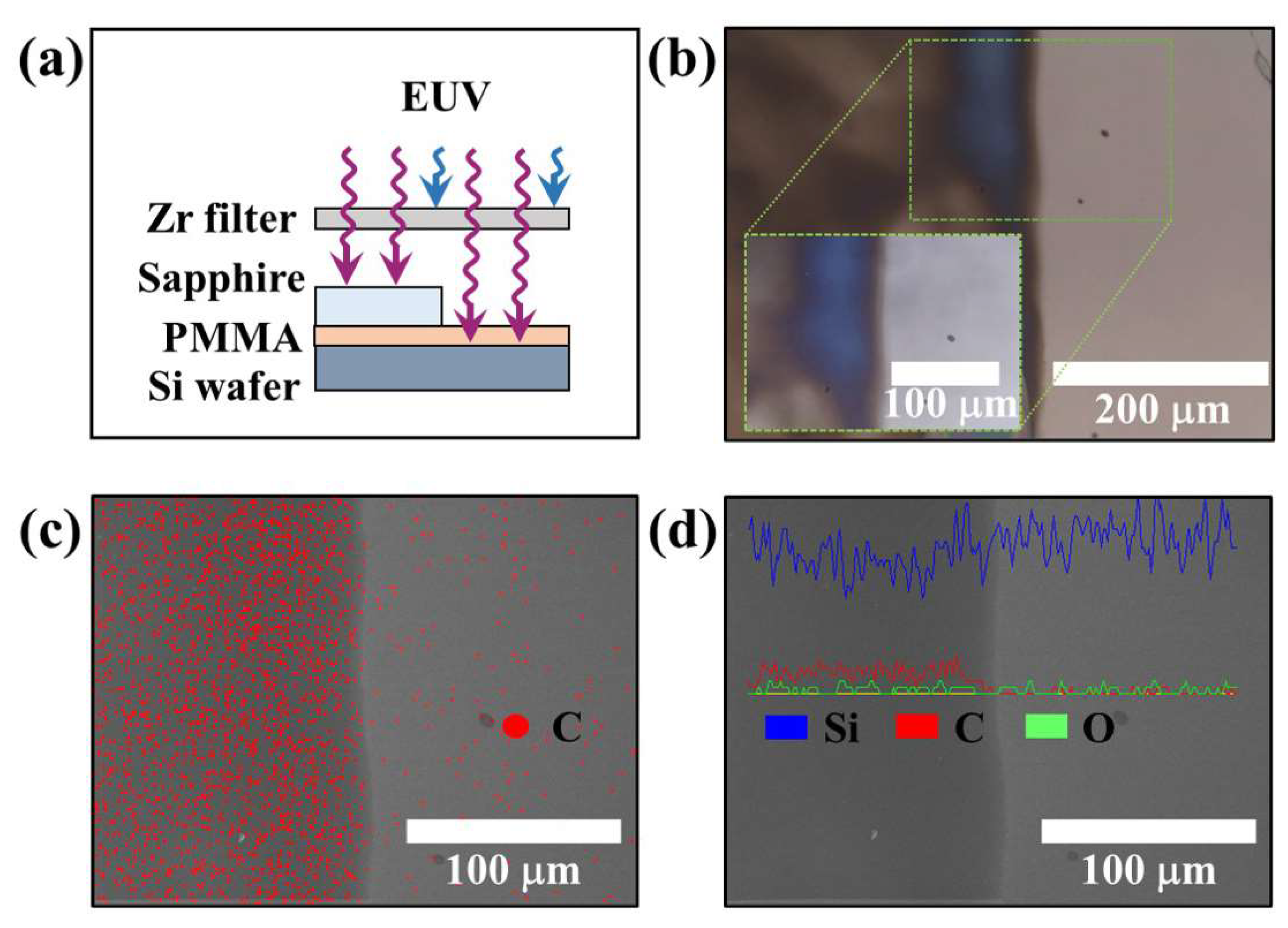
Publisher’s Note: MDPI stays neutral with regard to jurisdictional claims in published maps and institutional affiliations. |
© 2022 by the authors. Licensee MDPI, Basel, Switzerland. This article is an open access article distributed under the terms and conditions of the Creative Commons Attribution (CC BY) license (https://creativecommons.org/licenses/by/4.0/).
Share and Cite
Yoo, S.T.; Park, K.C. Extreme Ultraviolet Lighting Using Carbon Nanotube-Based Cold Cathode Electron Beam. Nanomaterials 2022, 12, 4134. https://doi.org/10.3390/nano12234134
Yoo ST, Park KC. Extreme Ultraviolet Lighting Using Carbon Nanotube-Based Cold Cathode Electron Beam. Nanomaterials. 2022; 12(23):4134. https://doi.org/10.3390/nano12234134
Chicago/Turabian StyleYoo, Sung Tae, and Kyu Chang Park. 2022. "Extreme Ultraviolet Lighting Using Carbon Nanotube-Based Cold Cathode Electron Beam" Nanomaterials 12, no. 23: 4134. https://doi.org/10.3390/nano12234134
APA StyleYoo, S. T., & Park, K. C. (2022). Extreme Ultraviolet Lighting Using Carbon Nanotube-Based Cold Cathode Electron Beam. Nanomaterials, 12(23), 4134. https://doi.org/10.3390/nano12234134




